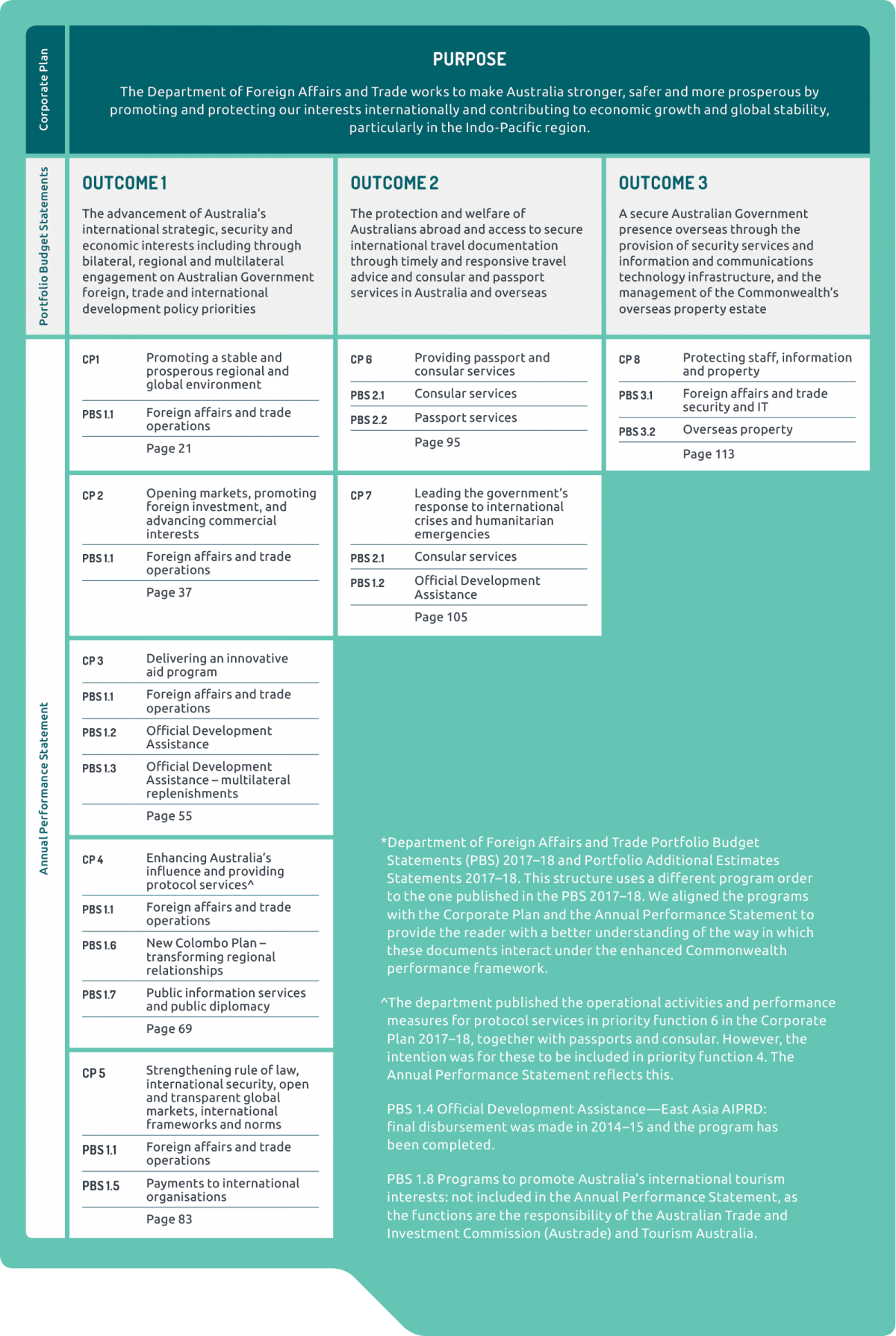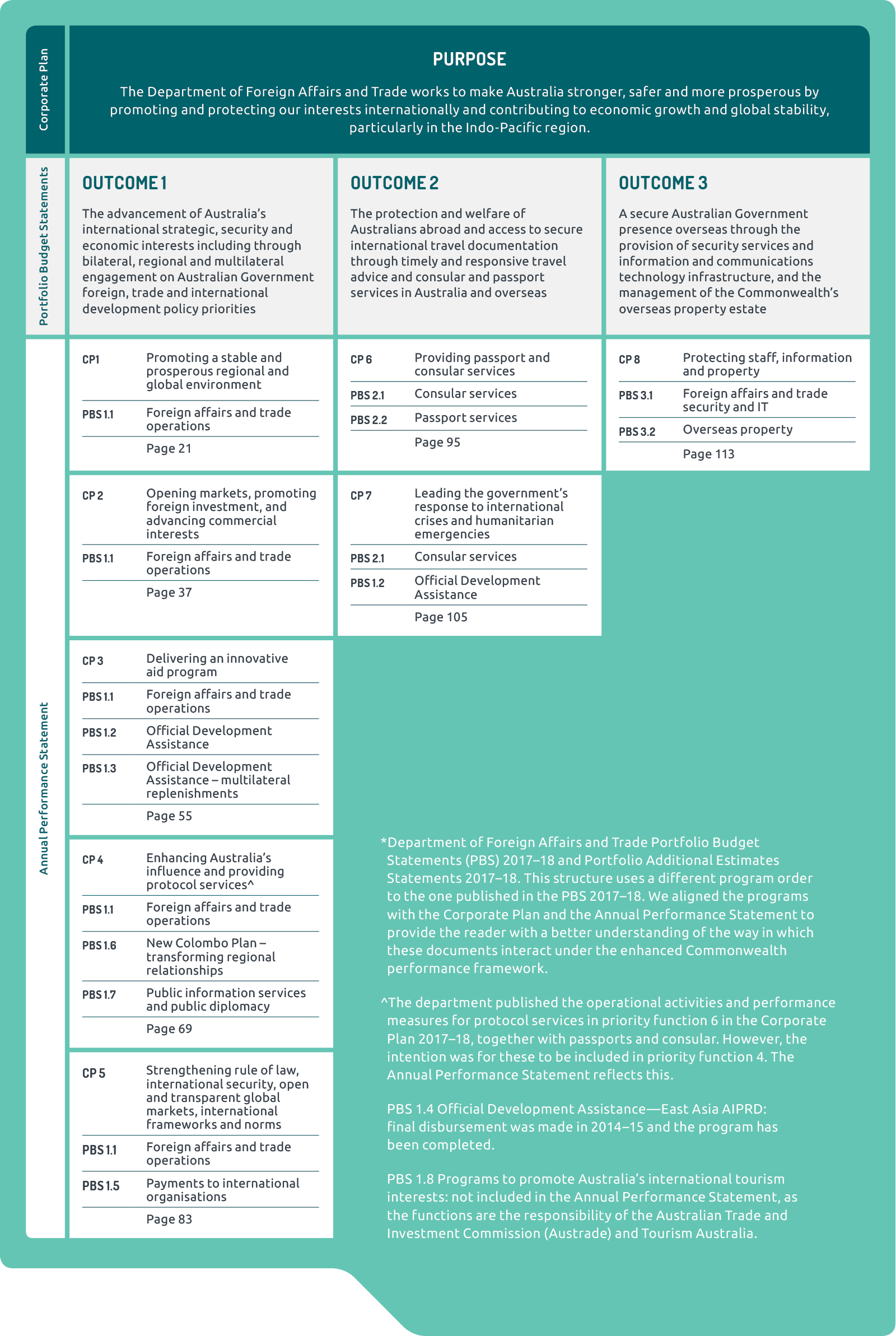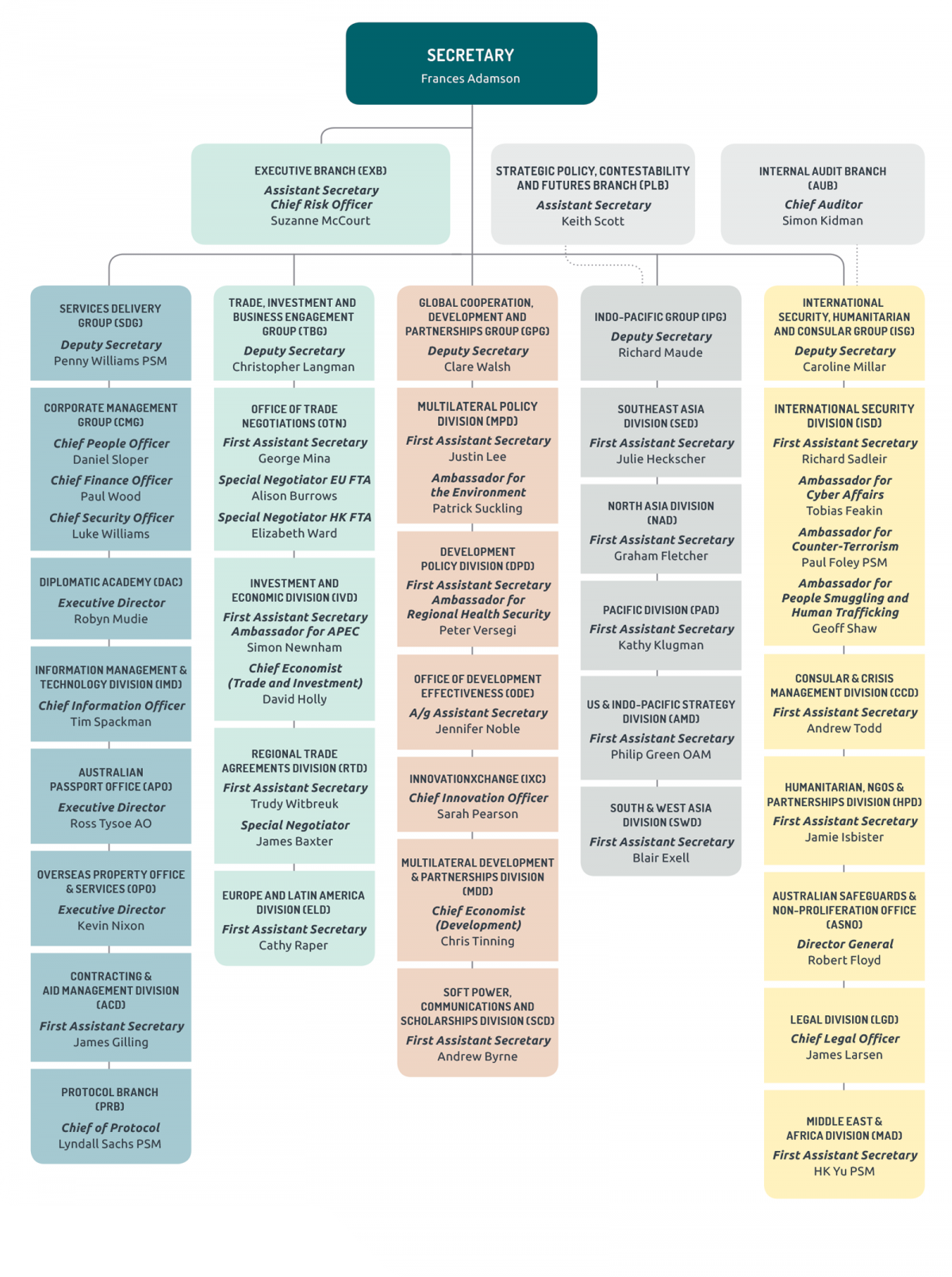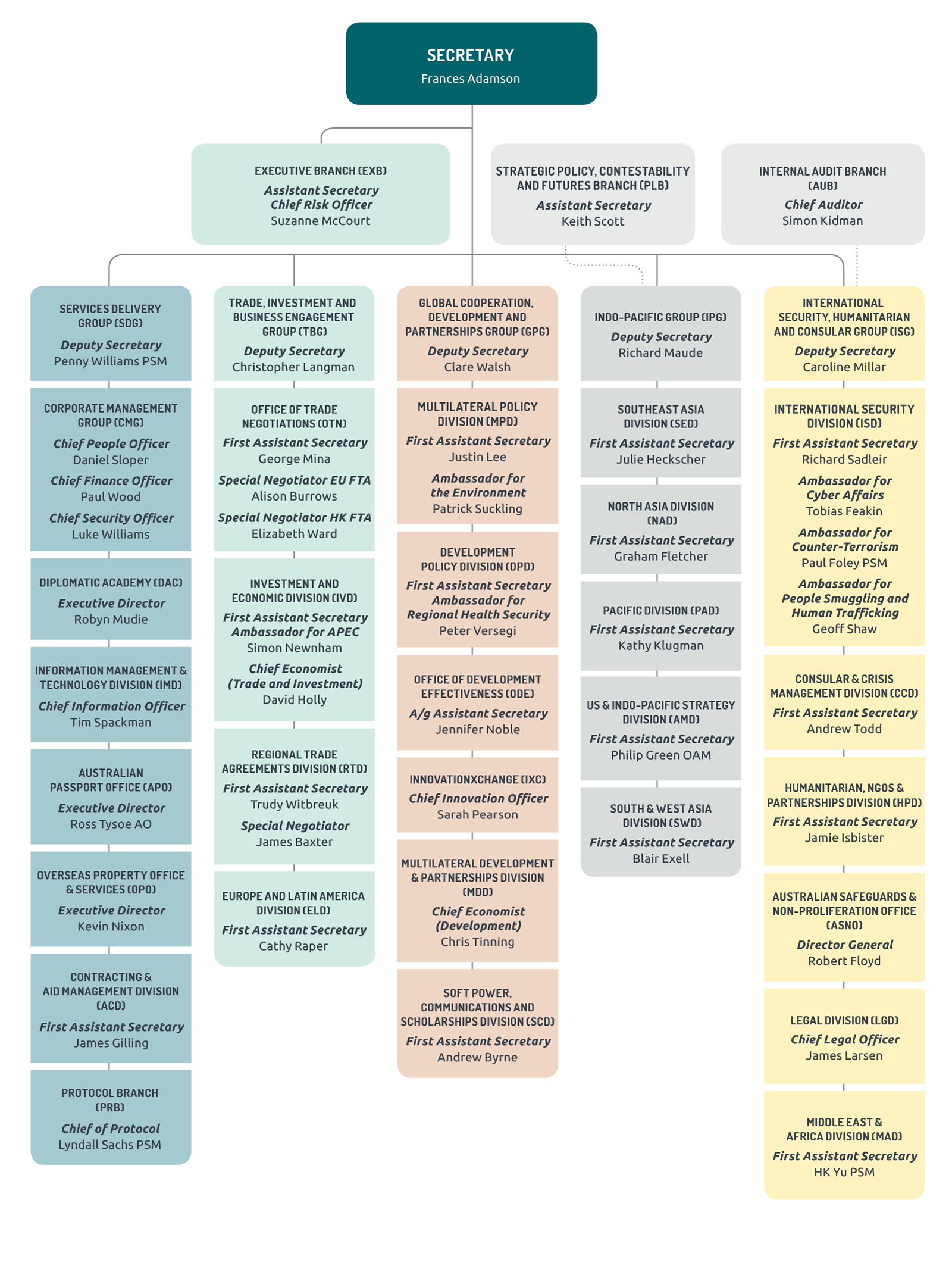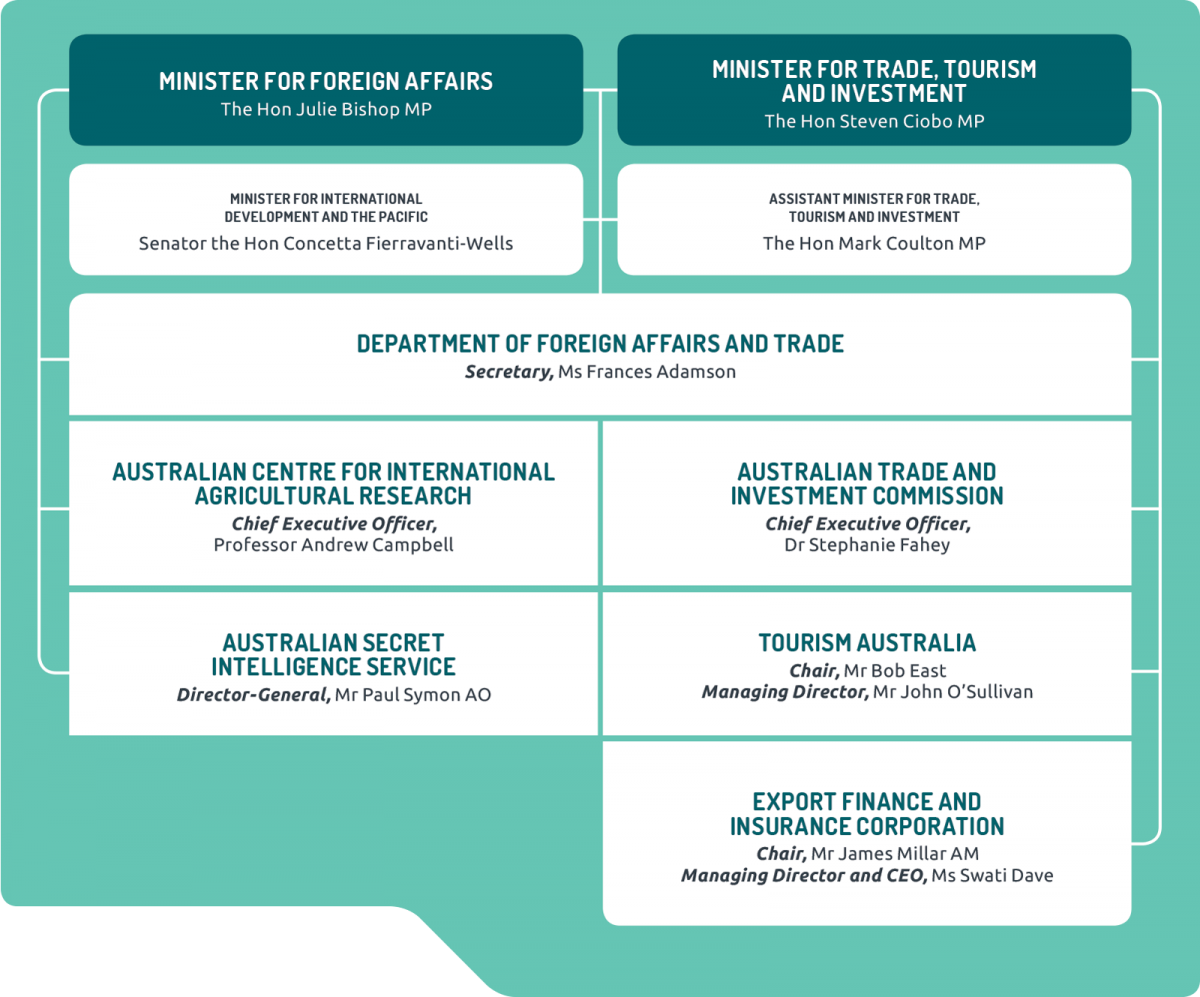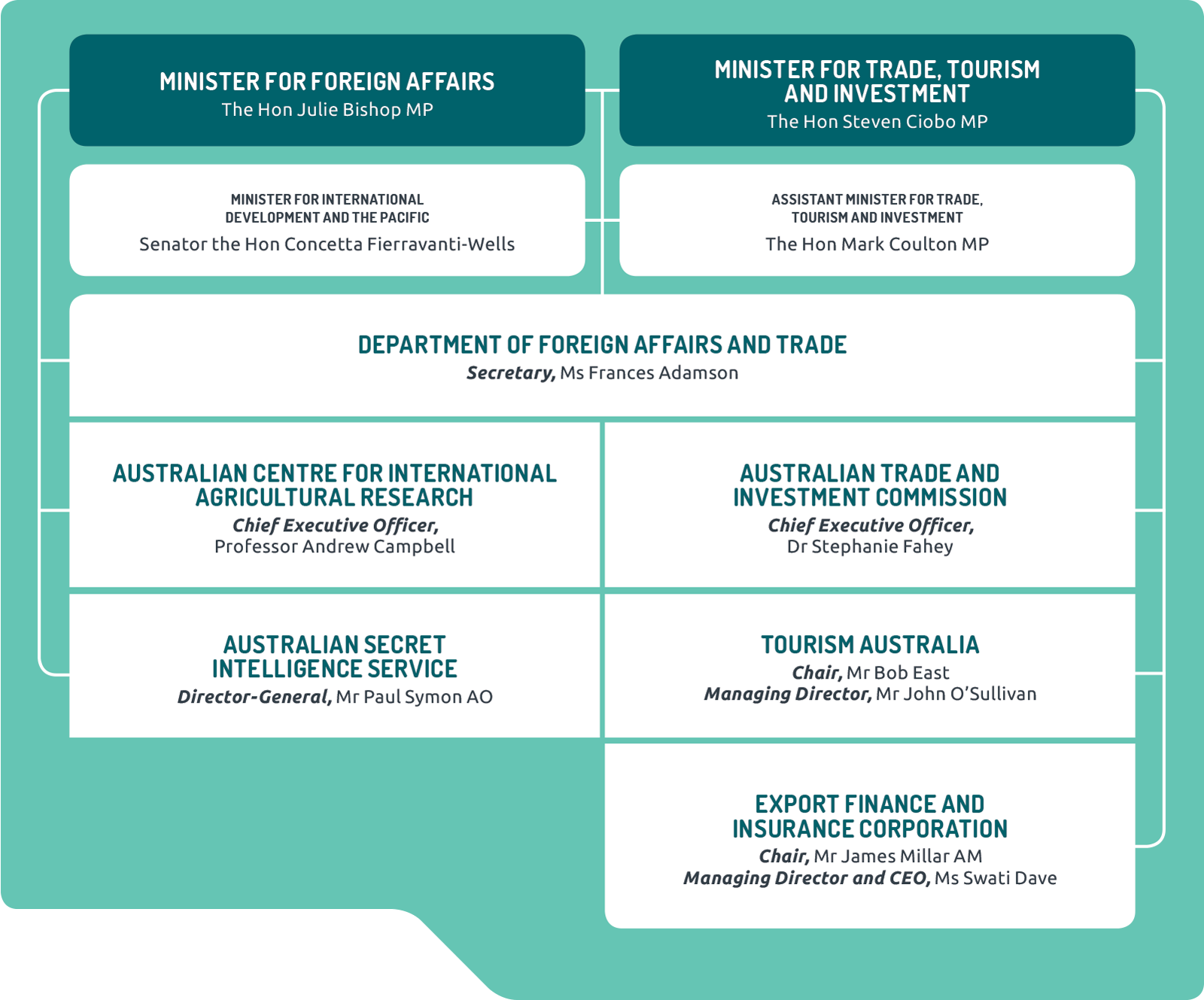Departmental Overview
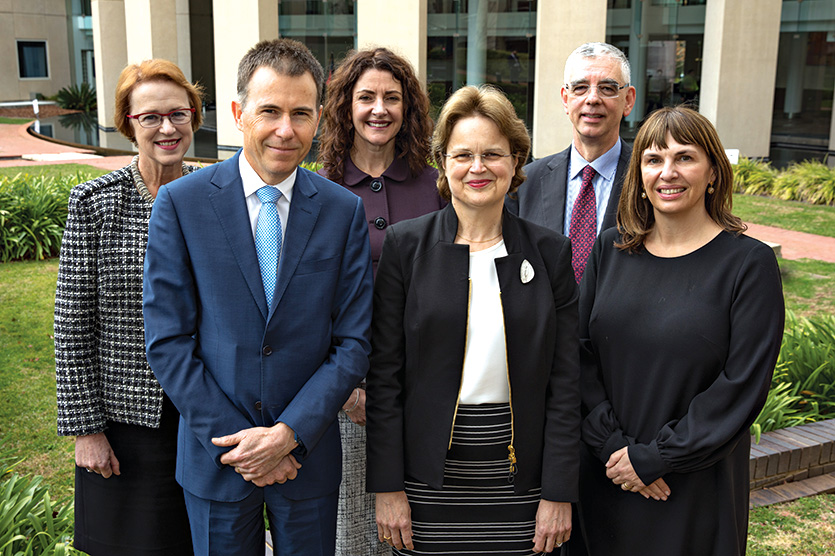
The executive, Department of Foreign Affairs and Trade. (L. to R.) Deputy Secretaries Caroline Millar, Richard Maude and Clare Walsh, Secretary Frances Adamson, Deputy Secretaries Christopher Langman and Penny Williams PSM [DFAT/Linda Roche]
On 22 November 2017 Prime Minister Malcolm Turnbull launched the White Paper—a comprehensive framework to advance Australia’s security and prosperity over the coming decade. In releasing the White Paper, the government reaffirmed the department’s critical role in providing strategic direction, leadership and policy coherence across an expanding foreign policy agenda.
As our 2017–18 Corporate Plan predates the White Paper, this year’s Annual Performance Statement addresses the Corporate Plan within the context of the White Paper’s objectives.
We revised the department’s organisational structure and allocated our resources to align with the strategic direction and priorities of the White Paper. Five newly established groups headed by deputy secretaries mirror the White Paper’s priorities and harness the services and capabilities required for their effective implementation. This new group structure promotes a sense of shared corporate leadership, and enables greater contestability and improved prioritisation and resource allocation in pursuit of the department’s objectives. The department is improving its governance structures to better harness performance information to inform judgements and priorities.
Flow chart of Corporate Plan Priority Functions and Portfolio Budget Statement outcomes.
2017–18: Corporate Plan (CP) Purpose:
The Department of Foreign Affairs and Trade works to make Australia stronger, safer and more prosperous by promoting and protecting our interests internationally and contributing to economic growth and global stability, particularly in the Indo–Pacific region.
Portfolio Budget Statements (PBS):
Outcome 1: The advancement of Australia’s international strategic, security and economic interests including through bilateral, regional and multilateral engagement on Australian Government foreign, trade and international development policy priorities.
CP 1: Promoting a stable and prosperous regional and global environment:
PBS 1.1 Foreign affairs and trade operations (p. 21).
CP 2: Opening markets, promoting foreign investment and advancing commercial interests: PBS 1.1 Foreign affairs and trade operations (p. 37).
CP 3: Delivering an innovative aid program:
PBS 1.1 Foreign affairs and trade operations, PBS 1.2 Official Development Assistance, PBS 1.3 Official Development Assistance – multilateral replenishments (p. 55).
CP 4: Enhancing Australia’s influence and providing protocol services^: PBS 1.1 Foreign affairs and trade operations, PBS 1.6 New Colombo Plan – transforming regional relationships, PBS 1.7 Public information services and public diplomacy (p. 69).
CP 5: Strengthening rule of law, international security, open and transparent global markets, international frameworks and norms: PBS 1.1 Foreign affairs and trade operations, PBS 1.5 Payments to international organisations (p. 83).
Outcome 2: The protection and welfare of Australians abroad and access to secure international travel documentation through timely and responsive travel advice and consular and passport services in Australia and overseas.
CP 6: Providing passport and consular services: PBS 2.1 Consular services, PBS 2.2 Passport services (p. 95).
CP 7: Leading the government’s response to international crises and humanitarian emergencies: PBS 2.1 Consular Services, PBS 1.2 Official Development Assistance (p. 105).
Outcome 3: A secure Australian Government presence overseas through the provision of security services and information and communications technology infrastructure, and the management of the Commonwealth’s overseas property estate.
CP 8: Protecting staff, information and property:
PBS 3.1 Foreign Affairs and trade security and IT, PBS 3.2 Overseas property (p. 113).
*Department of Foreign Affairs and Trade Portfolio Budget Statements (PBS) 2017–18 and Portfolio Additional Estimates Statements 2017–18. This structure uses a different program order to the one published in the PBS 2017–18. We aligned the programs with the Corporate Plan and the Annual Performance Statement to provide the reader with a better understanding of the way in which these documents interact under the enhanced Commonwealth performance framework.
^ The department published the operational activities and performance measures for protocol services in priority function 6 in the Corporate Plan 2017–1, together with passports and consular. However, the intention was for these to be included in priority function 4. The Annual Performance Statement reflects this.
PBS 1.4 Official Development Assistance—East Asia AIPRD: final disbursement was made in 2014–15 and the program has been completed.
PBS 1.8 Programs to promote Australia’s international tourism interests: not included in the Annual Performance Statement, as the functions are the responsibility of the Australian Trade and Investment Commission (Austrade) and Tourism Australia.
Organisational chart (as at 30 June 2018)
Flow chart of the organisational structure as at 30 June 2018: Secretary Frances Adamson; Executive Branch: Assistant Secretary and Chief Risk Officer Suzanne McCourt; Strategic Policy, Contestability and Futures Branch Keith Scott; Internal Audit Branch Chief Auditor Simon Kidman; Services Delivery Group Deputy Secretary Penny Williams PSM; Corporate Management Group: Chief People Officer Daniel Sloper, Chief Finance Officer Paul Wood, Chief Security Officer Luke Williams; Diplomatic Academy: Executive Director Robyn Mudie; Information Management and Technology Division: Chief Information Officer Tim Spackman; Australian Passport Office: Executive Director Ross Tysoe AO; Overseas Property Office and Services: Executive Director Kevin Nixon; Contracting and Aid Management Division: First Assistant Secretary James Gilling; Protocol Branch: Chief of Protocol Lyndall Sachs PSM; Trade, Investment and Business Engagement Group: Deputy Secretary Christopher Langman; Office of Trade Negotiations: First Assistant Secretary George Mina, Special Negotiator EU FTA Alison Burrows, Special Negotiator HK FTA Elizabeth Ward; Investment and Economic Division: First Assistant Secretary and Ambassador for APEC Simon Newnham, Chief Economist (Trade and Investment) David Holly; Regional Trade Agreements Division: First Assistant Secretary Trudy Witbreuk, Special Negotiator James Baxter; Europe and Latin America Division: First Assistant Secretary Cathy Raper; Global Cooperation, Development and Partnerships Group: Deputy Secretary Clare Walsh; Multilateral Policy Division: First Assistant Secretary Justin Lee, Ambassador for the Environment Patrick Suckling; Development Policy Division: First Assistant Secretary and Ambassador for Regional Health Security Peter Versegi; Office of Development Effectiveness: A/g First Assistant Secretary Jennifer Noble; innovationXchange: Chief Innovation Officer Sarah Pearson; Multilateral Development and Partnerships Division: Chief Economist (Development) Chris Tinning; Soft Power, Communications and Scholarships Division: First Assistant Secretary Andrew Byrne; Indo–Pacific Group: Deputy Secretary Richard Maude; Southeast Asia Division: First Assistant Secretary Julie Heckscher; North Asia Division: First Assistant Secretary Graham Fletcher; Pacific Division: First Assistant Secretary Kathy Klugman; US and Indo–Pacific Strategy Division: First Assistant Secretary Phillip Green OAM; South and West Asia Division: First Assistant Secretary Blair Exell; International Security, Humanitarian and Consular Group: Deputy Secretary Caroline Millar; International Security Division: First Assistant Secretary Richard Sadleir; Ambassador for Cyber Affairs Tobias Feakin, Ambassador for Counter-Terrorism Paul Foley PSM, Ambassador for People Smuggling and Human Trafficking Geoff Shaw; Consular and Crisis Management Division: First Assistant Secretary Andrew Todd; Humanitarian, NGOs and Partnerships Division: First Assistant Secretary Jamie Isbister; Australian Safeguards and Non-Proliferation Office: Director General Robert Floyd; Legal Division: Senior Legal Adviser James Larson; Middle East and Africa Division: First Assistant Secretary HK Yu PSM.
In support of our ministers, the Secretary and five Deputy Secretaries lead the department’s work in Australia and overseas.
We work closely with our portfolio partners to promote and protect Australia’s interests internationally, contributing to economic growth and global stability. With our global network, we are uniquely placed to:
- develop foreign and trade policy advice to government
- facilitate trade and investment
- deliver development assistance
- promote a whole‑of‑government international crisis response
- provide consular assistance
- issue secure passports efficiently
- provide protocol services
- manage Australia’s overseas property and systems
- ensure the security of Australian Government staff, information and property in Australia and overseas.
Figure 3: Foreign Affairs and Trade portfolio structure (as at 30 June 2018)
Flow chart of portfolio structure and outcomes: Minister for Foreign Affairs the Hon. Julie Bishop MP; Minister for International Development and the Pacific Senator the Hon. Concetta Fierravanti-Wells; Minister for Trade, Tourism and Investment the Hon. Steven Ciobo MP; Assistant Minister for Trade, Tourism and Investment the Hon. Keith Pitt MP. Department of Foreign Affairs and Trade. Secretary Ms Frances Adamson. Australian Centre for International Agricultural Research. Chief Executive Officer Professor Andrew Campbell. Australian Secret Intelligence Service.Director-General Mr Paul Symon AO. Australian Trade and Investment Commission.Chief Executive Officer Dr Stephanie Fahey. Tourism Australia. Chair Mr Bob East, Managing Director Mr John O’Sullivan. Export Finance and Insurance Corporation. Chair Mr James Millar AM, Managing Director and CEO Ms Swati Dave.
